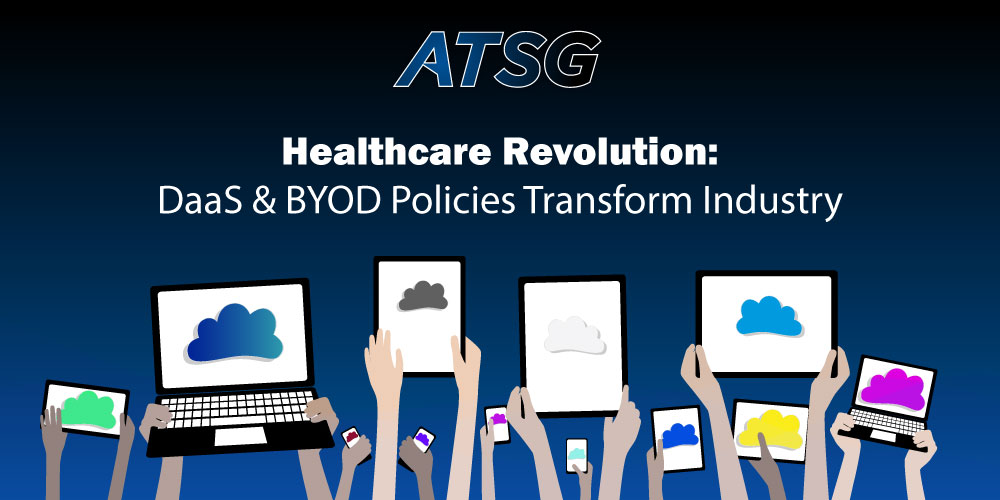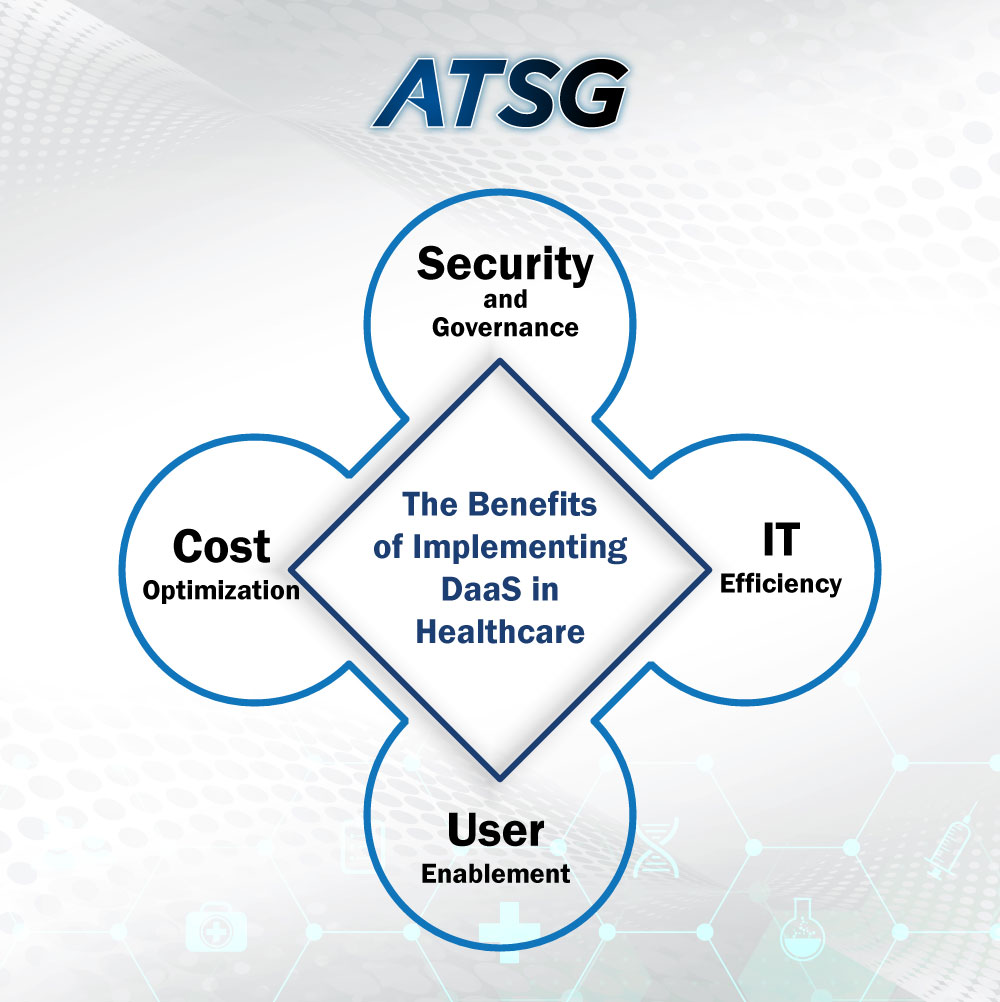The healthcare industry is rapidly evolving, with an increasing emphasis on providing patient-centric care and embracing digital transformation. In this ever-changing landscape, healthcare organizations are constantly seeking innovative solutions to improve their operations, enhance patient experience, and streamline workflows. Enter Desktop-as-a-Service (DaaS), a cloud-based solution that provides virtual desktops, applications, and data to users over the internet.
Desktop as a service (DaaS) market spending grew by 22% in 2022 compared with 2021 and is forecast to grow by 19% in 2023 as I&O leaders continue to adopt DaaS to enable remote work.

With its numerous benefits, DaaS is quickly gaining traction in the healthcare industry. In this article, we will explore how DaaS can benefit healthcare organizations and help them overcome some of the most common challenges they face.
DaaS is an effective mechanism to integrate across the healthcare industry, and provide virtualized cloud environments on any device with the data integrated for efficiency in workflows. For the modern healthcare industry, desktop-as-a-service or DaaS is the perfect solution to overcome multiple challenges.
Bring-Your-Own-Device (BYOD) Trending in Healthcare
Through research, experts found that healthcare providers and their employees find it convenient to utilize their own devices, especially when it comes to work-related concerns. Implementing BYOD policies in healthcare is considered a benefit for the employees and the healthcare industry, as it makes their work more efficient and effective. BYOD enables healthcare employees to access data and patient information easily, maintain confidentiality, and perform better.
However, with the benefits of BYOD, there are also some challenges that healthcare providers need to consider.
The Impact of DaaS on BYOD Policies in Healthcare
BYOD is less of a shift within IT, and more a cultural one. Organizations of any nature can no longer restrict devices or other means of connection. The IT teams and experts will have to find secure ways to allow those devices to interact with the IT ecosystems of healthcare providing institutions.
This is where desktop-as-a-service (DaaS) comes into the picture. Healthcare providers have been a major target of hacking and cybercrime, mainly due to their legacy digital mechanisms, and the highly sensitive nature of information they have in store.
DaaS has blurred the lines between personal and company owned devices. Now, employees can use their personal devices, without the fear of cyber attacks or data breaches. Prior to DaaS establishing itself as a secure remote work platform, organizations were hesitant about implementing BYOD policies.
The Challenges Faced by Healthcare Providers in BYOD
While BYOD in healthcare has several advantages, it also presents certain risks and challenges that need to be addressed. The following list explores the four major challenges of BYOD policies being integrated into healthcare.
Data Security and Compliance Concerns
Healthcare organizations are prime targets for ransomware attacks. Hackers often target corporate data, and they view employee-owned devices as an entry point for security breaches. Moreover, personal devices are more vulnerable to hacking and other cyber attacks, resulting in un-authorized access to patient data. It can be hard to monitor the flow of sensitive information when employees use their own devices, which can lead to severe penalties, in case of non-compliance or privacy violations.
Device Management
BYOD in healthcare can pose challenges for IT departments, mainly in managing and securing personal devices that are not directly in their control. One major concern is ensuring that all devices have updated security patches, antivirus software, and that insecure networks are not being used to access sensitive patient information, data or health records. The use of different devices can lead to confusion and errors that compromise security, and also increase the risk of data breaches.
Ensuring a Consistent User Experience (UX)
Healthcare providers face the challenge of delivering a consistent user experience, even if employees are not tied to any specific application or device. This can deteriorate the performance of employees, and jeopardize the ability of the healthcare provider to maintain all its sensitive data in one place.
Balancing the Cost and Benefits
It can be challenging to adopt cost effective remote work solutions, without having an elaborate BYOD policy in place. If a healthcare provider can strike the perfect balance between efficiency and security, BYOD policies can yield a wide range of benefits.
How DaaS Addresses BYOD Challenges?
The reason why BYOD policies could be risky is due to negligence, or lack of control over such environments. Developing strong security barriers and policies can help overcome the challenges of BYOD in healthcare.
Following are the components that make DaaS a key enabler for secure BYOD ecosystems, particularly in healthcare.
Enhanced Security and Compliance
With DaaS, all data stays in the data center, and is protected by strong monitoring, multiple security layers and robust backup systems. With DaaS, IT teams are able to manage the access of the employee to confidential data. DaaS centralizes data behind secure firewalls. Leading DaaS providers also comply with healthcare specific regulations, such as SSAE16 and HIPAA.
Simplified Device Management
Implementing a well managed DaaS platform will enable the healthcare organization to push rules to the tier of endpoint devices. This also includes changing device configuration settings, set multi-factor authentication, wipe devices remotely, and implement strong device encryption. The best tools out there lock-down end-user devices, as soon as they connect to the hospital’s network or resources. This way, the device is monitored and managed, and the data is protected from any chances of breach or leak.
Improved User Experience (UX)
Performance concerns can also be dealt with through DaaS, by using several data centers that are geographically isolated. With this capability, the end user is free to shift, without the un-favorable effect of network latency. It helps healthcare employees to get onboard with changes effectively and easily, without having to worry about device management.
The Benefits of Implementing DaaS in Healthcare
DaaS can be implemented across a wide range of industries, offering unique benefits. In terms of the benefits of DaaS for healthcare, it deems to provide seamless and secure connections that have the potential to improve operations, scalability, resilience and care delivery experiences.
Following are some major benefits that can be gained by Healthcare providers, by implementing DaaS solutions.

Security and Governance
It enables employees to access healthcare applications and databases from anywhere, anytime, and on any device, without compromising data security and integrity.
IT Efficiency
DaaS enables healthcare providers to seamlessly integrate with other IT stacks during mergers and acquisitions (M&A). This is made possible by the scalable architecture of DaaS solutions, and minimal upfront capital investment (CapEx).
User Enablement
DaaS in healthcare can empower workforces and physicians by leveraging predictive and prescriptive analysis, to proactively identify and treat patients. This reduces the overall burden on the healthcare system as a whole.
Cost Optimization
Implementing DaaS provides lag-free access and high-performance desktop infrastructure through relatively in-expensive systems, reducing the costs and expenditure on IT systems, hardware and software.
Key Considerations when Implementing DaaS for BYOD
The impact and benefits of DaaS on healthcare are vast and far-reaching. DaaS pitches technology as a potential force for good and enhanced patient care, without compromising on efficiency, privacy or security. A major aspect of implementing such solutions is choosing the right DaaS provider.
With BYOD becoming more common among healthcare providers, it is essential to prioritize the adoption of DaaS. Availing DaaS from leading tech firms like ATSG can help provide customized and effective solutions for healthcare organizations. ATSG offers multiple resources and professional consultation to adopt tools that would accommodate the needs of improving BYOD policies in healthcare.
Conclusively, adopting DaaS for promoting BYOD policies in healthcare can elevate and improve the functionality of workforces and operations. DaaS helps overcome the challenges posed by BYOD policies and practices in healthcare.
Opting for specialized DaaS providers, like ATSG, will enable your healthcare providing organization to focus more towards core tasks, instead of monitoring and supervising the on-premise IT infrastructure.
ATSG offers intelligent DaaS solutions, streamlining the implementation of BYOD policies that can improve the overall performance of healthcare providers.




